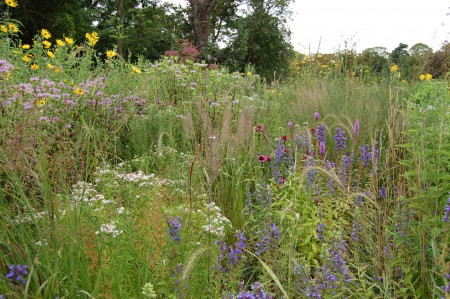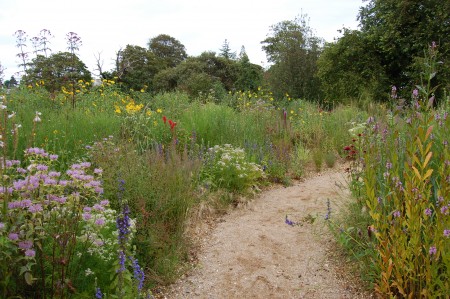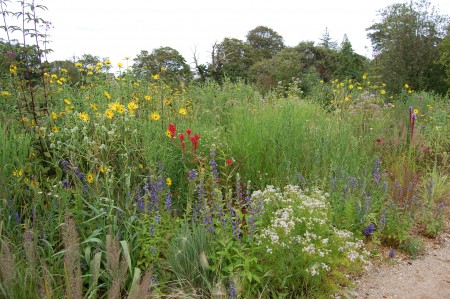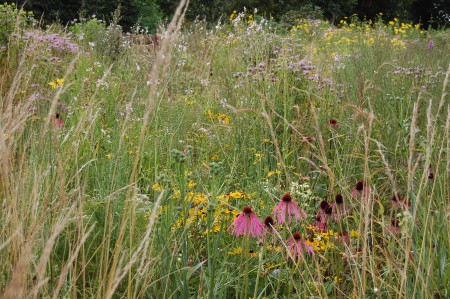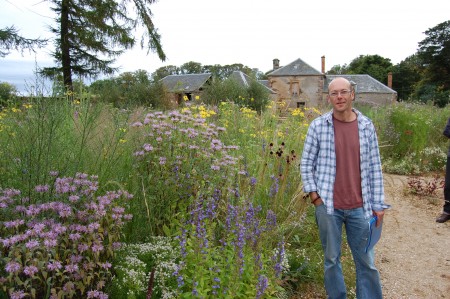OK, competition for you. Where is it?
Its prairie innit? So must be in the states, question is, which state?
FYI its now in its second year since planting out from one year old plugs, looks like its doing pretty well.
Some very tall Joe Pye weed – Eupatoriadelphus, as we must learn to call it, as the botanists have clearly been doing re-sorting. And some nice scarlet Lobelia cardinalis, but this is pretty short lived, so let’s hope it self-sows.
Echinacea, this one is E.pallida have become perhaps a bit too popular, they aren’t hugely long-lived at the best of times, but if you can get them through the first year they should keep going for at least five.
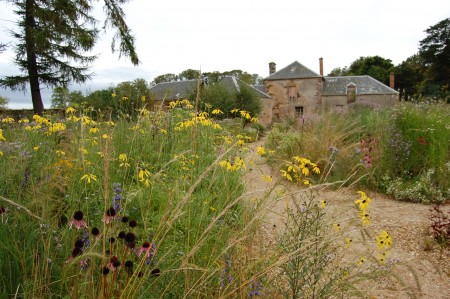 Eh, what’s this funny looking building, looks like it’s seen better days. Doesn’t look very Midwestern, or indeed very west side of the pond at all.
Eh, what’s this funny looking building, looks like it’s seen better days. Doesn’t look very Midwestern, or indeed very west side of the pond at all.
Here’s who made it, Elliott Forsyth, head gardener for Cambo gardens, just south of St. Andrews in south-east SCOTLAND.
!!@!!!
Pour yourself a wee dram of whisky and take another look.
I’ve written before about the apparent paradox of Europeans growing prairie plants. But there are good reasons and some good historical precedents. Good reasons first – the British flora is very poor on late-flowering native species, so if gardeners grow all this North American late prairie stuff the butterflies and a great many other insects have greatly increased food sources. Birds love the seedheads too. I’m sure seedhead productivity is far greater at this time than our natives.
The historical precedent is simply that during the early years of the 20th century perennial planting for grand late season ‘herbaceous borders’ became very popular. Wealthy garden lovers would employ armies of staff to cultivate them. Many of the species were North American, but they tended to be high-maintenance and the style gradually fell out of favour. With a modern range of mostly species plants however maintenance can be minimised.
Cambo is 56degrees north, way north of any prairie in North America, that’s like being on the southern shores of the main bit of Hudson Bay. Summer is cool but wonderfully light, and winters are not that cold, because of the weather systems coming in from the Atlantic, and then the North Sea is not that far either.
‘Far north’ gardeners lose out on really late things: vernonia (Ironweed) perhaps and some asters, and the grasses need a lot of heat so they grow really slowly, but there are plenty of ‘fake’ prairie grasses we can use, and some of our own native grasses can pass.
The moral seems to be, 1) there is no simple relationship between place of origin and plant growth requirements, and 2) growing natives is nice, but dogmatically clinging to the belief that only natives benefit wildlife is patent nonsense.
***************
I am now publishing e-books through Amazon, for Kindle, smartphones, iPads etc. There are currently two of collections of writings for Hortus magazine from the early 2000s, plus a transcription of an hour long interview with Beth Chatto, one of the most influential gardeners of modern times.

